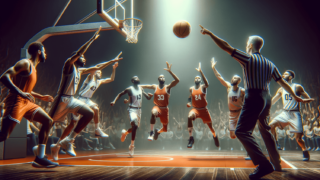
Imagine yourself on the basketball court, guarding your opponent with fierce determination, anticipating their every move, and then suddenly stepping in front of them, holding your ground, and absorbing the contact as they collide into you – this, my friends, is the art of taking a charge in basketball! Welcome to our in-depth exploration of this truly game-changing technique that can make all the difference for your team. In this fun and informative blog post, we’re going to break down the fundamentals, dissect the nuances, and share our top tips for mastering the beautiful craft of taking a charge in basketball. Stick with us, and you’ll soon be the defensive hero your team can rely on!
How to Take a Charge in Basketball?
To take a charge in basketball, follow these steps: 1) Maintain a solid defensive position with your feet shoulder-width apart and knees slightly bent. 2) Anticipate your opponent’s driving path, and position yourself firmly with both feet planted before they arrive. 3) Square up your body, protecting yourself with your chest and keeping your arms close to your side or slightly extended. 4) As the offensive player makes contact, hold your ground and allow them to collide with you, making sure not to move or lean into the contact. 5) Absorb the force to show the referee that you’ve been hit, then gracefully fall backward, keeping your head and limbs protected. If properly executed, the referee should call an offensive foul on the opponent, giving your team possession of the ball.
Planting the Seed: The Defensive Stance
The very foundation of taking a charge in basketball hinges on your defensive stance. By maintaining proper positioning, you’ll be better prepared to step in front of your opponent and absorb a potential charge. Let’s dive into the essentials of a strong defensive stance:
Feet Placement and Balance
One of the most critical aspects of a good defensive stance is having your feet shoulder-width apart. This positioning will provide you with ample balance, making it easier to react and adjust to the offensive player’s movements quickly. To further increase stability and improve your ability to take a charge, keep your weight distributed evenly between the balls of your feet and heels.
Knees and Posture
Keep your knees slightly bent, and your back straight. This posture will allow you to react quickly, shifting your weight side to side as needed. Proper knee and back positioning enable you to stay low, which is essential for maintaining great leverage and quick lateral movements.
Arms and Hands Placement
Keep your arms slightly away from your body and your hands up, ready to defend the basketball. This positioning keeps you prepared for action, whether defending a shot, a pass, or stepping in to take a charge. Utmost importance should be given to ensure that arms and hands are not excessively extended, as reaching too far can result in a foul.
Decoding the Offense: Anticipating Your Opponent’s Moves
While maintaining a solid defensive stance is crucial, your true edge on the court comes from being able to anticipate your opponent’s next move. The better you can read their actions, the more efficiently you’ll be able to step in and take a charge.
Watch the Ball Handler’s Hips
One valuable tip for anticipating an opponent’s movements is to pay attention to their hips. Hips don’t lie; they often indicate which direction the offensive player is headed. Keep your eyes on the ball handler’s hips, and react accordingly to position yourself in their driving path.
Look for Offensive Patterns and Tendencies
Another helpful tactic involves studying your opponent’s patterns and tendencies during gameplay. Look for clues as to how they react when driving to the basket, when they’re likely to pass the ball, or how they prefer to shoot. By understanding their habits, you can better predict their moves and step in before they even know what hit them.
Communication is Key
Never underestimate the power of communication on the basketball court. Talk to your teammates, share information about who you’re defending, and listen to their input. This valuable exchange of information can give you the critical intel you need to anticipate offensive plays and step in for a successful charge.
Stepping In: Proper Charging Techniques
Armed with your strong defensive stance and a keen sense of anticipation, it’s time to put it all into practice and learn how to take a charge effectively.
Establishing Legal Guarding Position
The first step in taking a charge involves setting yourself up in a legal guarding position. This means both feet must be planted on the ground, and you should establish this position before the offensive player arrives. Ensure that you’re not moving, leaning, or reaching toward the ball handler, as that could lead to an unsuccessful charge or even a blocking foul against you.
Squaring Up
Once you’ve got your feet planted, you’ll want to make sure your body is squared up to the incoming offensive player. Protect yourself by facing your opponent squarely, using your chest rather than your arms or shoulders to absorb the impact. Keep your arms close to your body or slightly extended but avoid stretching them out and getting a pushing foul called against you.
Absorbing Contact and Falling Back Gracefully
As the offensive player collides with you, it’s essential to absorb the contact without overreacting or exaggerating the force. Excessive flopping can result in a technical foul, so keep things real! Lastly, fall back gracefully, ensuring your head and limbs are well-protected. If you’ve done all of this correctly, there’s a good chance the referee will reward your efforts with an offensive foul called on your opponent, giving your basketball team a precious opportunity to regain possession.
Mastering the Charge: Perfecting Your Skills
By now, you should have a solid understanding of the fundamentals of taking a charge in basketball. But achieving true mastery over this skill requires practice, patience, and constant refinement. Here are some ways you can perfect your charge-taking abilities:
Drills and Simulation
Nothing beats regular and dedicated practice when it comes to mastering any basketball skill. Incorporate charging drills into your practice routine, and if possible, simulate game scenarios. Focus on your defensive stance, anticipation, establishing your position, and absorbing contact – repetition will help you hone your abilities to perfection.
Watch and Learn from the Pros
Always keep an eye out for professional players who excel at taking charges. Make your way through game footage to study and analyze their techniques, movements, and styles. Take note of the intricacies in their methods, and don’t hesitate to try and emulate them in your own game.
Coach’s Guidance
Enlist the help and guidance of an experienced coach or mentor to monitor and critique your charge-taking abilities. Constructive criticism can help you identify areas for improvement and fine-tune your skills to become the best defensive player you can be.
The Charge and Beyond: Building a Solid Defensive Game
While taking a charge is undoubtedly an impressive and valuable basketball skill, it’s important to remember that it’s just one piece of the larger defensive puzzle. To become a valuable asset to your team, it’s essential to develop other defensive techniques and strategies as part of a robust overall game. Combine charge-taking with skills like proper positioning, shot blocking, steals, and defensive rebounding to become a truly complete and indispensable player on the court.
Charge Awareness: Common Mistakes and Solutions
Even the best intentions can sometimes go awry when trying to take a charge in basketball. As you continue to develop this skill, be mindful of these common mistakes and implement these solutions to avoid costly errors and get the most out of your charge-taking abilities.
Sliding Underneath the Offensive Player
One frequent mistake occurs when defenders slide underneath the offensive player as they’re going up for a shot. Unfortunately, this move usually results in a blocking foul, allowing the ball handler to potentially earn points from the free-throw line. To avoid this, remember to establish your guarding position before the offensive player starts their upward shooting motion.
Leaning or Initiating Contact
Another common error is leaning into the offensive player or initiating contact when trying to take a charge. Doing so can lead to a blocking foul or a no-call scenario, in which case all your hard work goes to waste. To avoid this, ensure that you hold your ground and let the offensive player make contact.
Overusing the Charge
A key component of taking a charge is strategic timing, so don’t always try to take a charge every time an offensive player drives to the basket, even if you’re a charge enthusiast! Overusing this technique may result in opponents catching on, leading to more defensive breakdowns or increased foul trouble. Mix up your defensive approach, knowing when to step in for a charge and when to contest a shot or swipe for a steal.
Taking the Charge Safely
Despite the many benefits of taking a charge, it’s important to consider the potential risks associated with this defensive play. Collisions can lead to injuries, both minor and severe, if not executed with care. Here are a few pointers on how to prioritize safety when attempting to take a charge:
Use Proper Technique
The best way to take a charge safely is to practice and perfect your technique. This means maintaining a secure and strong defensive stance, keeping your body squared up (ready to absorb the contact with your chest), and properly protecting your head and limbs as you fall back.
Fall Back Properly
Ensure that you master the art of falling back safely after taking a charge. Remember to keep your chin tucked to your chest, use your arms to cushion your fall, and avoid landing on your wrists, shoulders, or neck. Falling back safely is not only crucial for your wellbeing but also helps convince the referees that the charge is genuine.
Listen to Your Body
Finally, always be mindful of your body’s limits and capabilities. Don’t push yourself to take charges in situations where you’re not confident or when there’s a heightened risk of injury. Basketball is meant to be enjoyed, so prioritize your safety and the safety of others on the court.
By avoiding common mistakes, practicing proper charge-taking techniques, diversifying your defensive plays, and prioritizing safety, you’ll be well-equipped to master the art of taking a charge in basketball. The road to success may be long, but the payoff is immense when you become an indispensable defensive force for your team!
FAQ: Taking a Charge in Basketball
Here is a concise list of frequently asked questions related to taking a charge in basketball, covering some of the most common concerns and queries typically faced by players. Our goal with this FAQ is to clarify any doubts and provide actionable information to bolster your charge-taking skills on the court.
1. What is the difference between a charge and a blocking foul?
A charge is called when the defender, in a legal guarding position, absorbs contact from an offensive player, often resulting in a change of possession. A blocking foul, on the other hand, occurs when the defender fails to establish a legal guarding position before contact, causing the offensive player to be impeded. In this instance, the foul is called on the defender.
2. Can a defensive player take a charge inside the restricted arc?
No, a defensive player cannot take a charge inside the restricted arc – this will result in a blocking foul. The arc is in place to ensure players’ safety and prevent defenders from sliding under an airborne offensive player, which can cause injury.
3. Can a player take a charge if they’re still moving?
To take a charge, the defender must be in a legal guarding position with both feet planted on the floor before contact. If the defender is still moving, it’s more likely that the referee will call a blocking foul instead of a charge.
4. Can you take a charge after the offensive player has released the ball?
Once the offensive player has released the ball, it becomes challenging to take a charge, as the referee might not call a foul on the now-ball-less player. Instead, focus on getting into position to contest the shot, grab a rebound, or defend another opponent.
5. Are there any specific conditioning exercises to improve charge-taking skills?
While there are no specific exercises solely for becoming better at taking charges, working on your overall strength and conditioning will undoubtedly improve your defensive capabilities. Focus on core strength, leg stability, and agility to improve your success rate in taking charges.
6. What can I do if the referee isn’t calling charges during a game?
If you feel the referee is overlooking charging fouls, continue to focus on maintaining a strong defensive stance and legal guarding position. Be patient and work on perfecting your technique. Even if calls aren’t being made, you can still effectively hinder the opponent’s offensive progress.
7. How can I reduce the risk of injury when taking a charge?
To minimize the risk of injury, focus on proper charging techniques: maintain a secure defensive stance, keep your body squared up, and protect your head and limbs as you fall back. Remember to master the art of falling back safely, cushioning the impact and avoiding awkward landings on your wrists, neck, or shoulders.
8. How can I practice taking charges without physical contact?
You can practice charge-taking techniques using visualization or shadow practice, focusing on maintaining a solid defensive stance, moving your feet, and establishing a legal guarding position. While this approach lacks physical contact, it can help reinforce fundamentals and improve your positioning on the court.
9. How can I avoid being called for a flop when taking a charge?
To avoid being called for a flop, ensure that you’re in a legal guarding position and maintain a strong defensive posture. Also, avoid overreacting, exaggerating contact, or initiating contact yourself. The key is to let the offensive player come to you, then absorb the impact genuinely and fall back safely.
10. Can I practice taking charges on my own?
While practicing with a partner or team is ideal for charge-taking drills, you can still work on fundamentals, positioning, and falling techniques on your own. Focus on strengthening your defensive stance and movements on the court using visualization, shadow practice, or agility exercises.
Featured Posts
- No pillar pages found.





